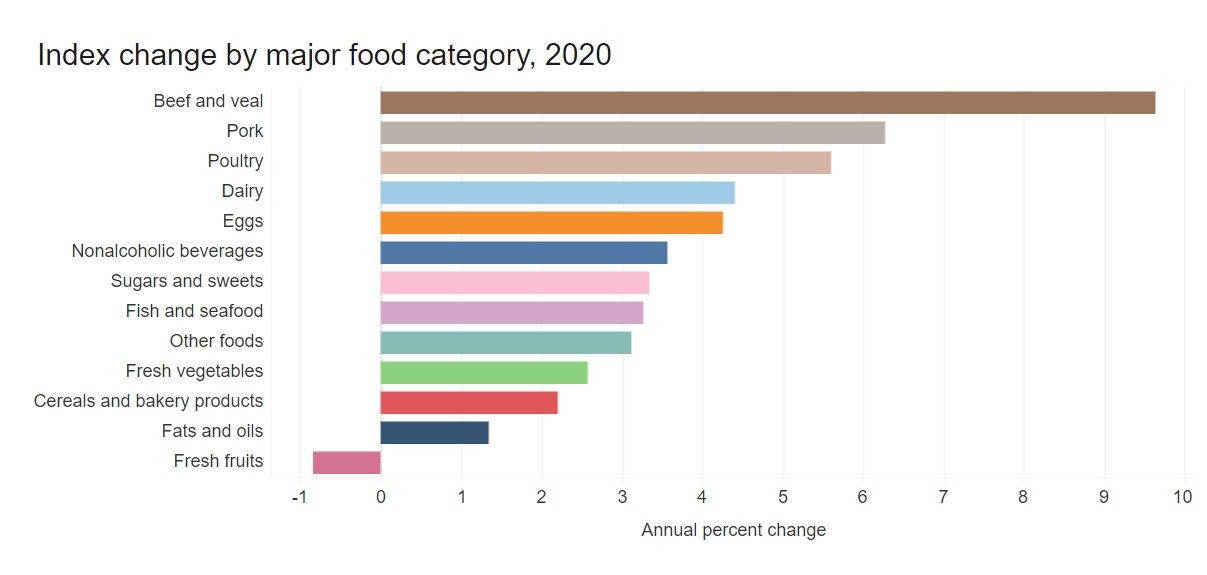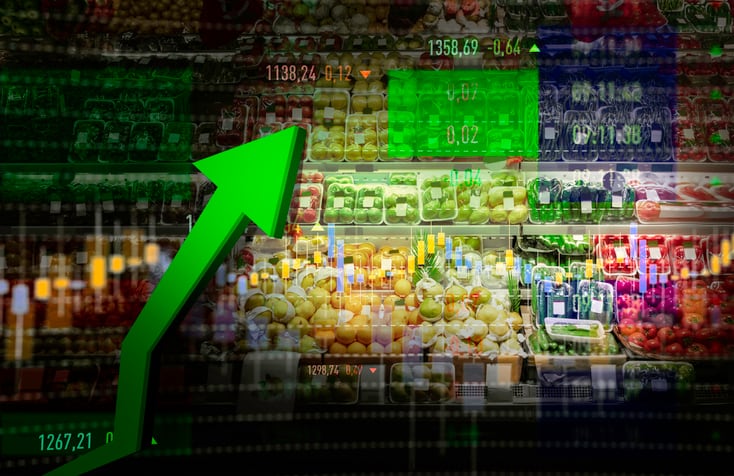The Consumer Price Index, which measures economy-wide inflation, for all food increased 0.8% from August to September – more than twice that of the all-items CPI – bringing the year-over-year increase for all food up 4.6% in September. The month-over-month bump is a mere 0.1% lower than the 0.9% increase for all food recorded for the full calendar year in 2019 and double that for calendar 2018, which marked the first increase in three years after two years of declines. But even then the increase was below the 20-year annual average of 2%.
The bulk of the increase last month came from food consumed at home and bought at grocery stores and supermarkets, which rose 1.1% from August to September compared to restaurant prices, which increased 0.5% in the same period. Compared to the same period last month, restaurant prices have risen more than those for food consumed at home – but just barely at 4.7% compared to 4.5% from September 2020 to September 2021.
The uptick this month drove up inflation for the full year up to 2.5% for food at home and 3.6% for restaurant food, according to USDA’s Economic Research Service, which predicts inflationary pressure on food prices is far from over.
“In 2021, food-at-home prices are expected to increase between 2.5 and 3.5%, and food-away-from-home prices are expected to increase between 3.5 and 4.5%,” the agency noted.
It also warned that increases will continue into the new year, with food-at-home prices expected to increase an additional 1.5 to 2.5% in 2022, and restaurant food expected to increase 3 to 4% next year.
CPG companies plan to pass more price to consumers
Food and beverage CPG companies have warned for months of the negative impact on their business of inflation related to continued supply chain challenges, particularly related to transportation, energy, packaging and select commodity costs.
The steady rise of inflation since the pandemic began has far outpaced most packaged food companies’ ability to hedge against market volatility with forward-looking purchases and has negatively impacted many firms’ contract negotiations for supplies and services going forward – resulting in multiple rounds of price increases in recent months and in the months to come.
The full brunt of the impact at the retail level is delayed due in part to earlier hedging – a strategy that typically insults the food and beverage CPG industry from inflation, Nestle CFO Francois-Xavier Roger explained to investors during the company’s third-quarter earnings report last week.
“Our industry, in general, is not an industry that is in normal times pinched by inflation. So, when you are in a regular inflationary rhythm, you roughly know what is going to be happening next and this industry can adjust and basically maintain,” he said.
However, until the current environment stabilizes, he added, Nestle will continue to use price increases and other levers to “make the best of it.”
Nestle is far from the only food and beverage CPG company making this choice. Unilever last week announced it raised prices a notable 4.1% in its third quarter on top of the 1.6% increase the previous quarter and the 1% increase in the first quarter. Executives also warned more increases are to come.
Other CPG companies that revealed or acknowledged considering additional price hikes in the near future include PepsiCo, Conagra, Albertsons, McCormick and others.
Meat prices rising fastest of all food, fruit prices drop
The hike in overall food prices has been felt across the board, except in fresh fruit, which is the only category to see prices decline in 2020 by 0.8%, according to USDA. But, it notes, beef/veal, pork and poultry continue to lead the increase in 2020 with upticks of 9.6%, 6.3% and 5.6%, respectively.
In 2021, beef and veal prices are predicted to increase 6.5 to 7.5%, pork 6.5 to 7.5% and other meat between 1.5 and 2.5%, according to USDA. Poultry is predicted to increase 3.5 to 4.5%. Combined, the ‘meat’ category is estimated to increase 5.5 to 6.5% for the year.
The impact inflation also has hit food harder than all other categories over the past 100 years, except for housing and medical care, according to USDA, which placed food inflation at 3.4% in 2020 and medical care at 4.1% for the year. Housing increased 2.2% in 2020, but since the late 1960s has inched above food over time.




